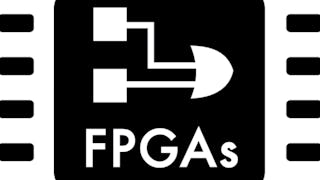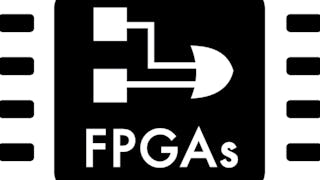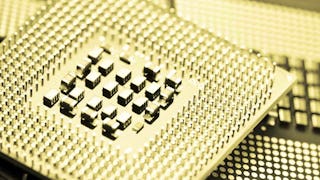This course will give you hands-on FPGA design experience that uses all the concepts and skills you have developed up to now. You will need to purchase a DE10-Lite development kit. You will setup and test the MAX10 DE10-Lite board using the FPGA design tool Quartus Prime and the System Builder.

Gain next-level skills with Coursera Plus for $199 (regularly $399). Save now.

FPGA Capstone: Building FPGA Projects
This course is part of FPGA Design for Embedded Systems Specialization

Instructor: Timothy Scherr
8,605 already enrolled
Included with
(24 reviews)
Recommended experience
What you'll learn
Create a working FPGA design using Quartus Prime and run it on an evaluation board
Understand and practice all aspects of FPGA development, including conception, design, implementation, and debugging.
Create in the FPGA a working system on a chip design with Nios II soft processor, RAM and FLASH memory, and several peripherals.
Become familiar with the FGPA development flow, particularly in the case of a SoC with software development flow included.
Skills you'll gain
- Program Development
- Hardware Design
- Engineering Documentation
- Laboratory Reports
- Embedded Systems
- Software Development Tools
- Laboratory Testing
- Laboratory Experience
- Eclipse (Software)
- Development Environment
- Electronic Hardware
- Electronic Systems
- Integrated Development Environments
- System Design and Implementation
- Software Development
- Field-Programmable Gate Array (FPGA)
- Embedded Software
- Build Tools
Details to know

Add to your LinkedIn profile
4 assignments
See how employees at top companies are mastering in-demand skills

Build your subject-matter expertise
- Learn new concepts from industry experts
- Gain a foundational understanding of a subject or tool
- Develop job-relevant skills with hands-on projects
- Earn a shareable career certificate

There are 4 modules in this course
In this module you will begin your hands-on exploration of FPGA design by setting up a target board, the DE10-Lite based on the MAX10 Intel Altera FPGA. In this module you will Setup and test the MAX10 board using the FPGA design tool Quartus Prime and the System Builder. Design and test a Binary Coded Decimal Adder Record all your observations in a lab notebook pdf. Submit your project files and lab notebook for grading. Completing this module will help prepare you for the work to be done in the modules that follow.
What's included
5 videos5 readings1 assignment6 programming assignments1 peer review1 discussion prompt
The goal of this module is to develop a mixed-signal system. You will construct hardware that uses the Analog to Digital Converter (ADC) inputs and Pulse Width Modulate (PWM) outputs to make a voltage measuring instrument. In this module you will Create a working design, using most aspects of the Quartus Prime Design Flow. Design and test a PWM Circuit, with verification by simulation. Design and test an ADC circuit, using Quartus Prime built-in tools to verify your circuit design. Record all your observations in a lab notebook pdf. Submit your project files and lab notebook for grading. Completing this module will help prepare you for the work to be done in the modules that follow.
What's included
2 videos1 reading1 assignment2 programming assignments1 peer review
The goal of this module is to develop the hardware for a System on a Chip (SoC). You will construct hardware that creates a NIOS II soft processor along with several interfaces to devices on the DE10-Lite development kit. In this module you will Create a working design, using most aspects of the Quartus Prime Design Flow. Create hardware for the NIOS II soft processor, including many interfaces, using Qsys (Platform Builder). Instantiate this design into a top-level DE10-Lite HDL file. Compile your completed hardware using Quartus Prime. Record all your observations in a lab notebook. Submit your project files and lab notebook for grading. Completing this module will provide a platform for the work to be done in the module that follows.
What's included
2 videos1 reading1 assignment1 programming assignment1 peer review
The goal of this module is to develop the software for a System on a Chip (SoC). You will build software for a NIOS II soft processor you built in Module 3, using several interfaces to devices on the DE10-Lite development kit as well. In this module you will Enhance and test a working design, using most aspects of the Quartus Prime Design Flow and the NIOS II Software Build Tools (SBT) for Eclipse. Create software for the NIOS II soft processor, including many interfaces, using Qsys (Platform Builder) and the SBT. Compile your completed software using the SBT. Use Quartus Prime to program both the FPGA hardware configuration and software code in you DE10-Lite development kit. You will then test your new embedded system. Record all your observations in a lab notebook pdf. Submit your project files and lab notebook for grading. Completing this module will finish your work for this course.
What's included
2 videos1 reading1 assignment1 programming assignment1 peer review
Earn a career certificate
Add this credential to your LinkedIn profile, resume, or CV. Share it on social media and in your performance review.
Build toward a degree
This course is part of the following degree program(s) offered by University of Colorado Boulder. If you are admitted and enroll, your completed coursework may count toward your degree learning and your progress can transfer with you.¹
Instructor

Offered by
Explore more from Electrical Engineering
 Status: Free Trial
Status: Free TrialUniversity of Colorado Boulder
 Status: Free Trial
Status: Free TrialUniversity of Colorado Boulder
 Status: Free Trial
Status: Free TrialUniversity of Colorado Boulder

Politecnico di Milano
Why people choose Coursera for their career




Learner reviews
24 reviews
- 5 stars
62.50%
- 4 stars
20.83%
- 3 stars
4.16%
- 2 stars
4.16%
- 1 star
8.33%
Showing 3 of 24
Reviewed on Nov 1, 2024
It is a great course to learn everything about FPGA, VHDL and Verilog.
Reviewed on Jan 25, 2022
In general a good course structure and content. It lacks support on question and exercises.
Reviewed on Oct 15, 2025
very good information auto graded is a big turn off

Open new doors with Coursera Plus
Unlimited access to 10,000+ world-class courses, hands-on projects, and job-ready certificate programs - all included in your subscription
Advance your career with an online degree
Earn a degree from world-class universities - 100% online
Join over 3,400 global companies that choose Coursera for Business
Upskill your employees to excel in the digital economy
Frequently asked questions
To access the course materials, assignments and to earn a Certificate, you will need to purchase the Certificate experience when you enroll in a course. You can try a Free Trial instead, or apply for Financial Aid. The course may offer 'Full Course, No Certificate' instead. This option lets you see all course materials, submit required assessments, and get a final grade. This also means that you will not be able to purchase a Certificate experience.
When you enroll in the course, you get access to all of the courses in the Specialization, and you earn a certificate when you complete the work. Your electronic Certificate will be added to your Accomplishments page - from there, you can print your Certificate or add it to your LinkedIn profile.
Yes. In select learning programs, you can apply for financial aid or a scholarship if you can’t afford the enrollment fee. If fin aid or scholarship is available for your learning program selection, you’ll find a link to apply on the description page.
More questions
Financial aid available,

